Thirty Minutes for the Birds
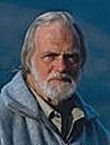 I
live in one of the most beautiful spots in the country. My home in
northwestern New Jersey is on rolling forested hillsides with the Blue
Ridge section of New Jersey's Appalachian Mountains rising up behind. The
ridge is actually the first escarpment of Pennsylvania's Pocono Mountains.
Although urbanization is happening all too fast in the surrounding areas,
it is still basically a rural area and much of it will stay that way
because of the thousands of acres of woodland owned by the Boy Scouts,
YMCAs and various universities for their camps. Most of the mountain
itself is part of the Worthington, Stokes and High Point state parks and
the Delaware Gap National Recreation Area. I
live in one of the most beautiful spots in the country. My home in
northwestern New Jersey is on rolling forested hillsides with the Blue
Ridge section of New Jersey's Appalachian Mountains rising up behind. The
ridge is actually the first escarpment of Pennsylvania's Pocono Mountains.
Although urbanization is happening all too fast in the surrounding areas,
it is still basically a rural area and much of it will stay that way
because of the thousands of acres of woodland owned by the Boy Scouts,
YMCAs and various universities for their camps. Most of the mountain
itself is part of the Worthington, Stokes and High Point state parks and
the Delaware Gap National Recreation Area.
 My
fourteen acres is a bird sanctuary. The entire property is enclosed by an
eight foot high chain link fence topped with three strands of barbed wire
to keep my research deer herd from wandering off. To enhance the area for
birds, I have planted tartarian honeysuckle bushes which produce bushels
of berries for the birds each summer when they are busy feeding their
young. I have a dozen birdhouses for the smaller birds and a dozen wood
duck boxes around my pond for the woodies, five were used this year. I
have allowed bushy areas to grow up and created brush piles to give the
birds immediate hiding places into which they can escape from danger. My
fourteen acres is a bird sanctuary. The entire property is enclosed by an
eight foot high chain link fence topped with three strands of barbed wire
to keep my research deer herd from wandering off. To enhance the area for
birds, I have planted tartarian honeysuckle bushes which produce bushels
of berries for the birds each summer when they are busy feeding their
young. I have a dozen birdhouses for the smaller birds and a dozen wood
duck boxes around my pond for the woodies, five were used this year. I
have allowed bushy areas to grow up and created brush piles to give the
birds immediate hiding places into which they can escape from danger.
I have often heard and read about the opinions and arguments, to which
I pay absolutely no attention, on the pros and cons of feeding the birds.
I feed the birds, and have all of my life, and I feed them all year long.
As I write this, I have two large shelf feeders on which I place the small
seed mixes that contain some sunflower seeds. The birds don't get many of
those sunflower seeds as they are quickly eaten by the numerous squirrels
that come running every time they hear me open the lids on the metal
containers, where the feed is stored.
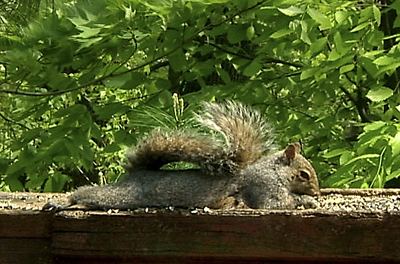 I
have a large squirrel-proof feeder, which I keep filled with black oil
sunflower seeds. It really is squirrel proof and I can always tell when
there is a new squirrel in the area as it will repeatedly attempt to get
the seeds out -- and invariably fails. The resident squirrels have all
failed so often and no longer even attempt to get to the seeds. The elfin
flying squirrels feed at that feeder each night, and I welcome their
presence. I
have a large squirrel-proof feeder, which I keep filled with black oil
sunflower seeds. It really is squirrel proof and I can always tell when
there is a new squirrel in the area as it will repeatedly attempt to get
the seeds out -- and invariably fails. The resident squirrels have all
failed so often and no longer even attempt to get to the seeds. The elfin
flying squirrels feed at that feeder each night, and I welcome their
presence.
There is also a suet feeder and, in the summertime, we have four
hummingbird feeders out. The air traffic around them is so heavy we almost
need a control tower as the air reverberates with the whirr of wings.
None of my feed ever gets moldy as the feeders are on a raised porch
and everything is kept dry. Beneath the porch railing and on every corner
of my house I planted trees and shrubs. No bird has to go over five feet
to reach the safety of shelter, while feeding at my feeders.
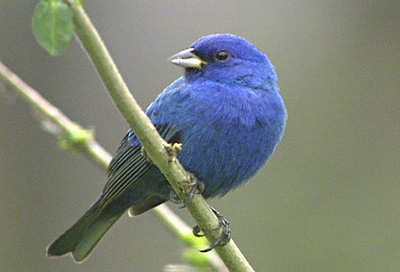 I
feed the birds because I get great pleasure in watching them and I feed
all summer because I enjoy watching the parents bring in their young to be
fed after they have fledged. By feeding all year long, I am not concerned
that "my" birds will leave here and go to other feeders. Year
round feeding assures me all of the birds that their territoriality will
allow. I
feed the birds because I get great pleasure in watching them and I feed
all summer because I enjoy watching the parents bring in their young to be
fed after they have fledged. By feeding all year long, I am not concerned
that "my" birds will leave here and go to other feeders. Year
round feeding assures me all of the birds that their territoriality will
allow.
However, the feeding areas cannot be claimed by any particular birds,
though some of them definitely try. In the wintertime I have at least
fifteen different species coming to my feeder and before a storm comes in,
I often have as many as 150 birds at a time. The best I have ever done was
to have sixteen male cardinals in view at one time.
In addition to the pleasure that I get, the birds also broaden my
knowledge as a naturalist and are an unending source of opportunities for
me as a wildlife photographer.
Actually, that is what this column is about. One afternoon this summer,
about 4:00 p. m., my wife Uschi and I were enjoying a few restful moments
on our patio, sipping iced tea and nibbling on a snack. Suddenly one of
the five green frogs that are living in our little pond started to call. I
have filmed the frogs many times, but I have never gotten video and audio
of them calling. In less time than it takes to talk about it I had the
camera set up, but the frog refused to cooperate; I got nothing.
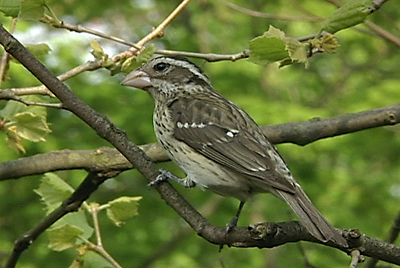 |
|
Female rose-breasted
grosbeak |
While waiting for the frog, we were admiring the beauty of the three
male and two female rose-breasted grosbeaks that were coming in to the
feeder. The hummers were zipping in and out, the cardinals flashed in, in
a constant parade and we even had an indigo bunting and a male red-bellied
woodpecker. House Finches, English Sparrows, Tufted Titmice, Red-winged
Blackbirds, Brown-headed Cowbirds and Chipping Sparrows were also adding
to the din.
Over the years I have photographed all of these species and I know full
well that I will continue to photograph them over the coming years. The
light was just perfect, the weather optimal and the subjects were at hand.
What photographer could pass up the chance to do an even better job?
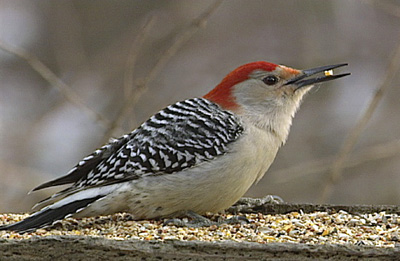 I
set my camera up on the porch at sixteen feet from the feeder. Naturally
some of the birds were a little closer while a number of them were a
little further when I photographed them, but I mention the distance at
which the birds accepted me because some of them had fed here all of their
lives and knew they were safe. When you can achieve that kind of rapport
with any kind of wildlife, the success of your photography will depend
only upon your skill with your camera. And you, too, can achieve that kind
of rapport if you provide the birds with security and an unending source
of food. I
set my camera up on the porch at sixteen feet from the feeder. Naturally
some of the birds were a little closer while a number of them were a
little further when I photographed them, but I mention the distance at
which the birds accepted me because some of them had fed here all of their
lives and knew they were safe. When you can achieve that kind of rapport
with any kind of wildlife, the success of your photography will depend
only upon your skill with your camera. And you, too, can achieve that kind
of rapport if you provide the birds with security and an unending source
of food.
I fully realize that not all of you have fourteen acres that you can
turn into a sanctuary. But I want you to realize that, unless you live in
an apartment house, you can do most of the things that I have just
described, even if you have only a standard lot in the middle of a suburb.
After all, birders have found over two hundred species of birds in Central
Park in the heart of New York City.
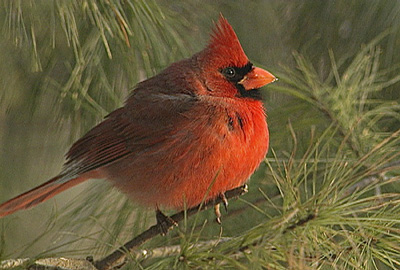 Although
most bird photography has to be done from a blind, and I use a number of
them all the time, I didn't use one that day. I just parked my camera on
my deck and stood absolutely still. Standing absolutely still is quite an
achievement in its own right; few people can actually do it. Oh, there are
lots of people who think they are holding absolutely still, but to
wildlife it looks like they have been fathered by a whirling dervish. The
only time I moved was to focus slightly, which required the slightest
rolling of the focusing ring with my left hand. I do all of my camera
functions manually. And when I moved my camera as my subjects changed, I
moved it EVER SO SLLLOWWWLY. Although
most bird photography has to be done from a blind, and I use a number of
them all the time, I didn't use one that day. I just parked my camera on
my deck and stood absolutely still. Standing absolutely still is quite an
achievement in its own right; few people can actually do it. Oh, there are
lots of people who think they are holding absolutely still, but to
wildlife it looks like they have been fathered by a whirling dervish. The
only time I moved was to focus slightly, which required the slightest
rolling of the focusing ring with my left hand. I do all of my camera
functions manually. And when I moved my camera as my subjects changed, I
moved it EVER SO SLLLOWWWLY.
I shot over a period of just about thirty minutes that day, and was
rewarded with some great images. I've enclosed a few, so you can judge for
yourself.
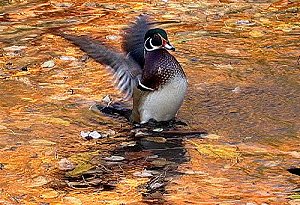 Photographic
Opportunity Photographic
Opportunity
Wood Ducks
Thirty years ago I had a 3/4 acre pond constructed on my property
so I could photograph waterfowl and other species in my own
backyard.
My refuge here in Northwestern New Jersey is strictly for
photography and I put out tons of feed each year, and although the
ducks and geese may be hunted elsewhere, they find a safe haven
and plenty of food here at all times.
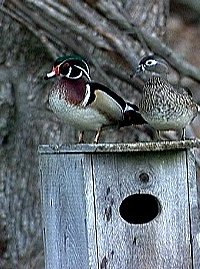 I
have built permanent blinds and use our Rue Ultimate photo blinds.
I have also put up, and maintain, a dozen wood duck nest boxes.
From March till October I average about 3 dozen wood ducks on my
pond at one time, although I have had as many as 76. I
have built permanent blinds and use our Rue Ultimate photo blinds.
I have also put up, and maintain, a dozen wood duck nest boxes.
From March till October I average about 3 dozen wood ducks on my
pond at one time, although I have had as many as 76.
I usually average a couple dozen mallard ducks year round, but
often have as many as 100, as well as a few black ducks. A pair of
resident Canada geese raises a brood of goslings here each year
and at other times of the year I often have a dozen or more geese
coming in to feed.
Deer, herons, gray squirrels and song birds visit the pond
while turtles live in it and crawl out on the logs.
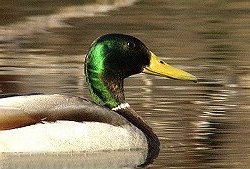 My
refuge will be open on a very limited basis, for personally
conducted "pay per shoot" photography. The wood ducks
should be back by mid-March and I recommend that photography be
done in March, April and May, while the females are laying eggs in
the boxes and the males are in close attendance, sitting in the
trees and on the logs, etc. My
refuge will be open on a very limited basis, for personally
conducted "pay per shoot" photography. The wood ducks
should be back by mid-March and I recommend that photography be
done in March, April and May, while the females are laying eggs in
the boxes and the males are in close attendance, sitting in the
trees and on the logs, etc.
For information, price and to schedule an appointment please
contact our office at 908-362-6616 and ask for Leonard Lee Rue III
or visit our Web site at http://www.ruevideo.com/photo_opportunity.html.
|
 Subscribe to
Vivid Light
Subscribe to
Vivid Light
Photography by email
Tell
Us What You Think
|

|


 I
set my camera up on the porch at sixteen feet from the feeder. Naturally
some of the birds were a little closer while a number of them were a
little further when I photographed them, but I mention the distance at
which the birds accepted me because some of them had fed here all of their
lives and knew they were safe. When you can achieve that kind of rapport
with any kind of wildlife, the success of your photography will depend
only upon your skill with your camera. And you, too, can achieve that kind
of rapport if you provide the birds with security and an unending source
of food.
I
set my camera up on the porch at sixteen feet from the feeder. Naturally
some of the birds were a little closer while a number of them were a
little further when I photographed them, but I mention the distance at
which the birds accepted me because some of them had fed here all of their
lives and knew they were safe. When you can achieve that kind of rapport
with any kind of wildlife, the success of your photography will depend
only upon your skill with your camera. And you, too, can achieve that kind
of rapport if you provide the birds with security and an unending source
of food. Although
most bird photography has to be done from a blind, and I use a number of
them all the time, I didn't use one that day. I just parked my camera on
my deck and stood absolutely still. Standing absolutely still is quite an
achievement in its own right; few people can actually do it. Oh, there are
lots of people who think they are holding absolutely still, but to
wildlife it looks like they have been fathered by a whirling dervish. The
only time I moved was to focus slightly, which required the slightest
rolling of the focusing ring with my left hand. I do all of my camera
functions manually. And when I moved my camera as my subjects changed, I
moved it EVER SO SLLLOWWWLY.
Although
most bird photography has to be done from a blind, and I use a number of
them all the time, I didn't use one that day. I just parked my camera on
my deck and stood absolutely still. Standing absolutely still is quite an
achievement in its own right; few people can actually do it. Oh, there are
lots of people who think they are holding absolutely still, but to
wildlife it looks like they have been fathered by a whirling dervish. The
only time I moved was to focus slightly, which required the slightest
rolling of the focusing ring with my left hand. I do all of my camera
functions manually. And when I moved my camera as my subjects changed, I
moved it EVER SO SLLLOWWWLY.  Photographic
Opportunity
Photographic
Opportunity